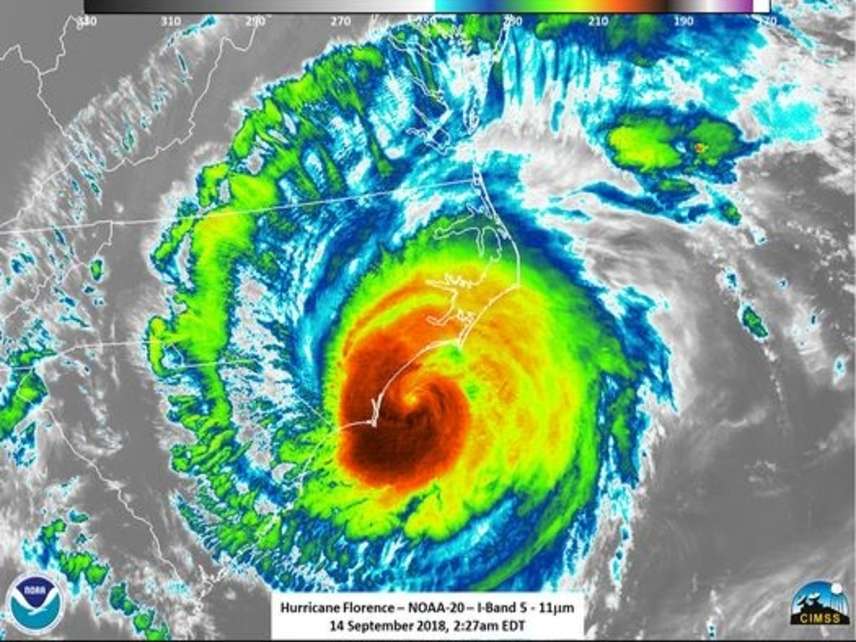Is Climate Change Making Hurricanes More Destructive?
Not yet in the United States, new studies suggest

"This year has shown us that climate change is a present-day threat to the safety and livelihoods of communities across America," Georgia Institute of Technology climate scientist Kim Cobb told The New York Times last September, shortly after Hurricane Florence struck North Carolina.
"Damages are increasing because the severity of the storms are increasing," Nathaniel Keohane, a climate expert at the Environmental Defense Fund, told The Hill in October. "We can say these impacts are worse, these storms are more severe, the risk of more extreme outcomes are more probable. That's the way that climate change has reshaped our worlds."
Last year, Hurricanes Florence and Michael caused about $50 billion and $15 billion in damages, respectively. Florence's destruction came chiefly from the flooding that ensued after the storm dumped nearly three feet of rain on eastern North Carolina. Michael's 155 mile per hour winds obliterated such Florida panhandle coastal towns as Mexico Beach. As bad as that was, the costs of 2018's hurricanes were considerably lower than the $265 billion in damages wreaked by Hurricanes Harvey, Irma, and Maria in 2017.
So is U.S. hurricane damage increasing because climate change is boosting the severity of the tropical storms? It's complicated.
A November article in Nature Sustainability developed normalized cost trends for hurricane damage in the United States from 1900 to 2017. The normalization process attempts to estimate direct economic losses from a historical storm as if that same event were to occur under contemporary social conditions.
For example, the Great Miami Hurricane of 1926 is estimated to have caused $105 million (in 1926 dollars) in damage when it hit. But the researchers calculate that today a storm of that magnitude would cause about $236 billion in losses. Overall, the researchers report that between 1900 and 2017, "197 hurricanes resulted in 206 landfalls with about US$2 trillion in normalized (2018) damage, or just under US$17 billion annually. Consistent with observed trends in the frequency and intensity of hurricane landfalls along the continental United States since 1900, the updated normalized loss estimates also show no trend."
But are fiercer hurricanes becoming more frequent? A July 18 article by the Colorado State University climatologist Philip Klotzbach and his colleagues in the Bulletin of the American Meterological Association finds that "since 1900 neither observed CONUS [continental United States] landfalling hurricane frequency nor intensity shows significant trends." The upshot is that so far, hurricanes amplified by climate change have not been the cause of increasing storm losses in the U.S. Rather, the chief reason for higher losses is that there is much more property to be destroyed along the Atlantic and Gulf coasts than there used to be. Overall, the trend in normalized losses is basically flat.
The frequency and intensity (and consequently damage) of U.S. landfalling hurricanes tracks changes in the cold and warm phases of the Atlantic Multidecadal Oscillation (AMO). In general, the years 1900–25 and 1970–94 are classified as negative (cold) AMO periods, and 1926–69 and 1995–2017 are classified as positive (warm) AMO periods.
"Median U.S. normalized hurricane damage shows statistically significant modulations by the AMO, with ?9 times as much median damage in a positive AMO season compared with a negative AMO season," note Klotzbach and his colleagues. The AMO is apparently switching back to a cold phase, which suggests, if past trends are sustained, that Altantic hurricane activity will abate somewhat in the coming years.
While there are no trends in the frequency and intensity of U.S. hurricanes, the global story is a bit different. The MIT climatologist Kerry Emanuel reports a significant global increase since 1980 in all storms with maximum wind speeds above 175 kilometers per hour (109 miles per hour). Storms of 200 km/h (125 mph) and more have doubled in number, and those of 250 km/h (155 mph) and more have tripled.

Climatologist Ryan Maue tracks global tropical cyclone activity (hurricanes, typhoons, cyclones). He also finds that since 1980 the trend (the bottom trend line) toward bigger storms has been slightly increasing:
So what's the takeway for the public and policy makers? "If you live on a street named River Road," the retired Army lieutenant general in charge of Hurricane Katrina recovery efforts quips to The New York Times, your home "is going to flood." But however climate change affects hurricanes, we should all keep firmly in mind geographer Gilbert F. White's 1945 observation that "floods are acts of God, but flood losses are largely acts of man."
One particularly stupid "act of man" is the fiscal insanity of subsidized federal flood insurance that encourages people to build on floodplains and in flood-prone coastal areas. Phasing out this program would reduce property losses and put fewer lives at risk regardless of how big a threat climate change turns out to be.


Show Comments (59)